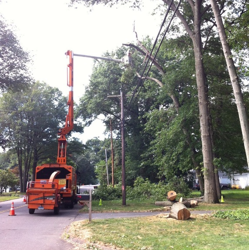- Homepage
- >
- Tree & Forest Management
- >
- Trees & People
Trees & People
Trees beautify the New England landscape, define the seasons and enhance both urban and rural scenery. In addition, they provide wildlife habitat, and many ecosystem services including mitigation of air and water pollution. However, trees are the greatest threat to utility infrastructure during a storm, causing nearly 90% of power outages.
Eversource and UConn are partnering up with communities to work on developing programs for maintaining healthy trees and woodlands in proximity to power lines. These programs will benefit local landowners and residents that need reliable power for their homes, businesses, town activities and community events.
Not everyone in a community can be expected to understand the needs of everyone else. When it comes to roadside tree and forest management, there is a large and diverse crowd of stakeholders and this partnership opens dialogue opportunities and enhances understanding of preferences for tree and forest management in urban, suburban and rural communities across Connecticut.
Social scientists at UConn, specializing in natural resource management, are running several research projects aimed at understanding the attitudes about the management of roadside trees and forests, about storms, and about the reliability of electrical power. They are also looking at opportunities for education to foster understanding of the different issues faced by land managers, residents and utilities. Input and buy-in from the community will be vital to any action plan. With input and greater understanding from all sides, it will be possible to manage roadside trees and forests for aesthetic qualities and ecological benefits as well as for public safety and reliability of electric power.

|
Goals & Project Updates
The primary intent of this project is to understand the stakeholder perceptions of utility vegetation management. Stakeholders include community residents, public officials, utility managers and professional arborists and foresters. Goals include:
- Understand barriers to and opportunities for statewide implementation of the Stormwise program.
- Explore the needs of homeowners, private landowners, municipal and other public officials, professional organizations, tree and forest managers, and other stakeholders in regard to conditions within which individuals are willing to adopt Stormwise tree management strategies.
- Understand public perceptions of power loss, utility vegetation management including tree removal and trimming, and regarding the use of wood resources from vegetation management efforts in local communities.
Print / Media
As of Spring 2018:
Resident Survey:
Self administered surveys were used ti measure attitudes towards vegetation management. In Feb., 2016, 3600 surveys were mailed to a random sample of residents in tow areas of eastern and western Connecticut that were along urban-rural gradients. Survey questions addressed storms, power outages, trees and different tree management strategies. More than 1000 surveys were returned. A spatial analysis is also underway to look at variation in attitudes along the urban-rural gradient.
Wood recovery Tree Crew Interviews:
Utility vegetation management generates large quantities of wood. Stormwise partnered with United Illuminating and Eversource Energy on a biomass recovery project to reduce wood waste, promote wood re-use and generate revenue for municipal tree planting. Utility tree crews were trained to keep wood chips clean of debris and preserve the bottom log of a tree where possible. Pilot programs were established in North Haven and Haddam in 2015 and interviews were done with crews that both had and had not implement the program, to understand the perceptions for potential wood recovery.

A tree crew works to manage vegetation along overhead power lines.
Team Members
|
Anita Morzillo, Assistant Professor, Department of Natural Resources and the Environment, University of Connecticut. |
|
Jason Parent, Assistant Research Professor, Department of Natural Resources and the Environment, University of Connecticut. |
|
Tom Worthley, Associate Extension Professor, Department of Natural Resources and the Environment, University of Connecticut. |
|
Christine Kirchhoff, Assistant Professor, Department of Civil and Environmental Engineering, University of Connecticut. |
|
Dr. John C. Volin, Vice Provost for Academic Affairs & Professor in the Department of Natural Resources and the Environment department, University of Connecticut. |
|
Emlyn Crocker, Graduate Assistant, Department of Natural Resources and the Environment, University of Connecticut. |
|
Jacob Cabral, Graduate Assistant, Department of Natural Resources and the Environment, University of Connecticut |
Contact Information
|
For more information, please contact Anita Morzillo (anita.morzillo@uconn.edu). Members of the media, please contact Center Manager Malaquias Pena (mpena@uconn.edu) directly. |
Eversource Energy Center | Innovation Partnership Building: 159 Discovery Drive, Unit 5276, Storrs, CT 06269-5276 | E-Mail: eversourceenergycenter@uconn.edu